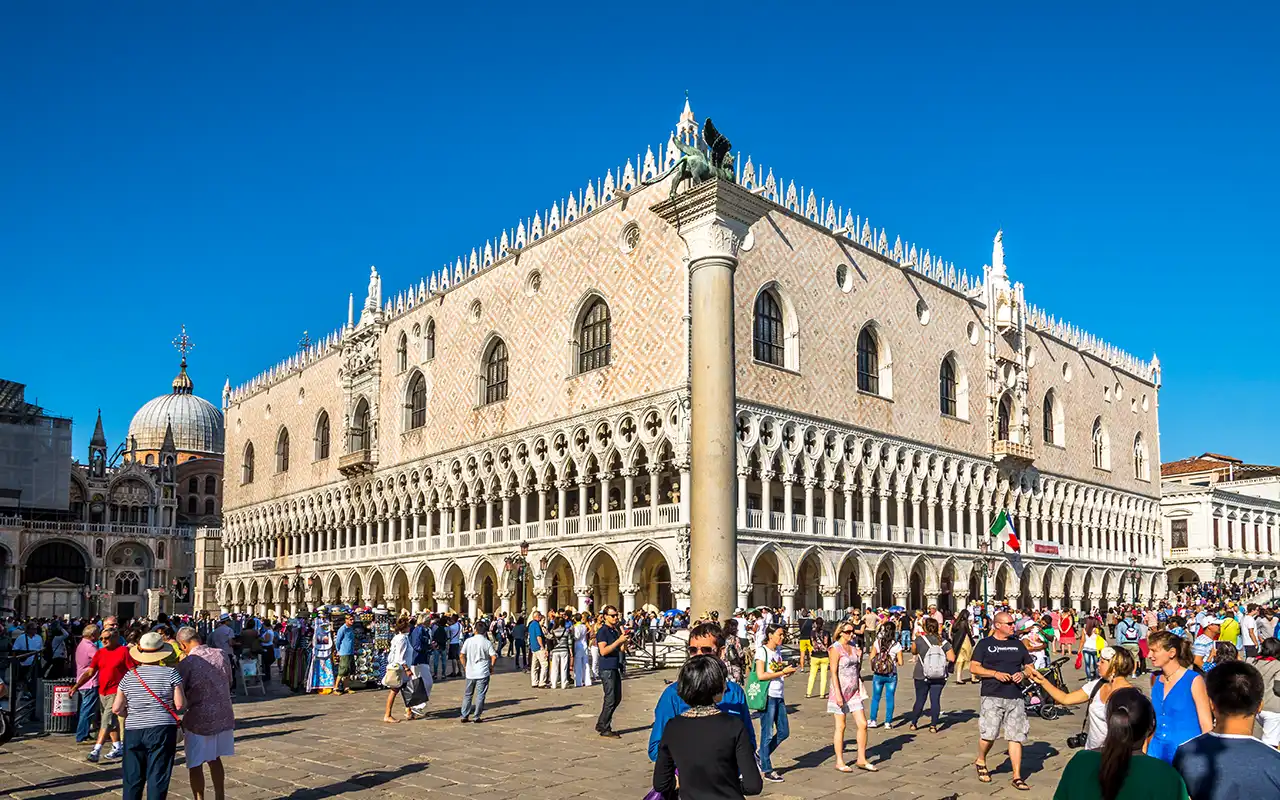
Navigating Doge's Palace : Answers to common questions
- Admission Fee: Admission fees are required for entry, with various ticket options available, including combined tickets with other nearby attractions.
- How Long to Visit: A visit can last 1-3 hours, depending on interest in the extensive art collections, architecture, and history offered.
- Washrooms: Accessible washroom facilities are available within the palace.
- Hours of Operation: Opening hours vary, typically from morning to early evening. It's advisable to check the current schedule before visiting.
- Important Information: Doge's Palace, a symbol of Venice's rich history and power, offers visitors a glimpse into the city's past with its grand architecture, art collections, and the iconic Bridge of Sighs.
- Handicap Accessible: Doge's Palace is accessible to visitors with disabilities, offering elevator access to the main floors, though some areas may have limitations due to the building's historic nature.
- Pets: Pets are not allowed inside Doge's Palace, with the exception of service animals.
- Guided Tours: Guided tours are available and highly recommended to fully appreciate the historical and artistic significance of the palace.
- Restaurant or Cafe: There are no dining facilities inside Doge's Palace, but nearby cafes and restaurants in St. Mark's Square offer various options.
- Gift Shop: The palace features a gift shop where visitors can purchase souvenirs, books, and art-related items.
- Parking: Parking is not available directly at Doge's Palace due to its location in Venice. Visitors typically use public transport or park at designated areas on the mainland or the island's edges.
- Family Friendly: The palace is suitable for families, but the historical and artistic content may be more appreciated by older children and adults.
- Photography: Photography is permitted in some areas of Doge's Palace, but flash photography and tripods may be restricted, especially in art and exhibition spaces.
- WIFI: Public WIFI is generally not available within the palace.
- Picnic Area: Picnic areas are not available at Doge's Palace. Outdoor dining is possible in nearby areas, respecting Venice's regulations on public spaces.
Please note all times and prices subject to change. Please check the offical website for details.
Throughout its many centuries as a city or city-state (before it became part of Italy proper in 1866), Venice has enjoyed and endured many forms of government. At one extended point in its history, it was ruled by the Doge (pronounced Dough-zsh), a “royal consanguinity” leader. This rule came to an end for good at the time of the Napoleonic occupation of Venice in 1797.
More in our list of Things To Do In Venice
;Venice Current Weather
Local Temp: 20.4℃ / 68.7℉
High: 21.8℃ / 71.2℉
Low: 19℃ / 66.2℉
Humidity: 65 %
Local Time: 13:31
Map for Doge's Palace
Did You Know?
Not just a residence for the Doge, the palace also housed political institutions of the Republic of Venice until the Napoleonic occupation in the early 19th century. This included the Great Council and the Council of Ten, among others, which were crucial in the administration of the city-state.
The interior of the Doge's Palace is adorned with works by some of the most celebrated artists of the Renaissance, including Tintoretto and Veronese. Their paintings and frescoes cover the walls and ceilings of the palace’s grand chambers, telling the story of Venice’s past glory and power through art.
The palace is intricately connected to the prison cells through the Bridge of Sighs, a covered bridge made of white limestone that passes over the Rio di Palazzo. The bridge's name, given by Lord Byron in the 19th century, suggests that prisoners would sigh at their final view of beautiful Venice through the window before being taken down to their cells.
Doge's Palace in Venice, Italy, is a masterpiece of Gothic architecture, serving as a symbol of the city's wealth and power in its heyday. It was the residence of the Doge of Venice, the supreme authority of the former Venetian Republic, making it one of the most important buildings in the city.
The Doge's Palace was not only a center of power and administration but also a fortress and jail. Its architecture includes features designed for defense, such as arrow slits in the walls and a complex system of barred windows for the prison cells, illustrating the multifaceted role of the palace in Venetian society.
Travel Information for
Venice Visitors
Time Zone: Venice operates on Central European Time (CET), which is 1 hour ahead of Greenwich Mean Time (GMT+1).
Weather: Venice has a humid subtropical climate. Summers are warm and humid with average temperatures around 27°C (81°F), while winters are cold with temperatures averaging around 3°C (37°F). Acqua alta (high water) is a phenomenon that causes flooding in Venice, typically occurring in autumn and winter.
Population: Venice has a population of about 260,000 residents. However, this number is steadily decreasing due to various factors, including rising living costs and flooding issues.
Size: The city covers an area of about 414.6 square kilometers (160.1 square miles), including both the lagoon and the historical city.
Language: Italian is the official language. Venetian, a distinct dialect of Italian, is also widely spoken. English is commonly used in tourist areas.
Currency: Italy uses the Euro (€). Credit cards are widely accepted, but it’s always useful to have cash for smaller shops and restaurants.
Safety: Venice is generally safe for tourists. However, like in any major tourist destination, it's wise to be cautious of pickpockets and scams targeting tourists.
Tipping: Tipping in Venice is not obligatory, but it's appreciated. In restaurants, it’s customary to leave a small tip (around 5-10%) if the service is good.
Electricity and Plugs: Italy uses Type C, F, and L plugs, and the standard voltage is 230 V with a standard frequency of 50 Hz. Travelers from countries with different standards will need adapters.
Water: Tap water in Venice is safe to drink. In fact, it's known for being high quality.
Verified & Trusted Contact Information for Doge's Palace
Address:
Piazza San Marco, 1
Website: palazzoducale.visitmuve.it/en/home/
Latitude: 45.4337
Longitude: 12.3409
More Places and Things To Do in Venice Within 500 km/300 mi of Doge's Palace
The Peggy Guggenheim Collection

The Distance from Doge's Palace to The Peggy Guggenheim Collection is 0.8 KM / 0.5 MI
The Dorsoduro neighborhood

The Distance from Doge's Palace to The Dorsoduro neighborhood is 1.2 KM / 0.7 MI











